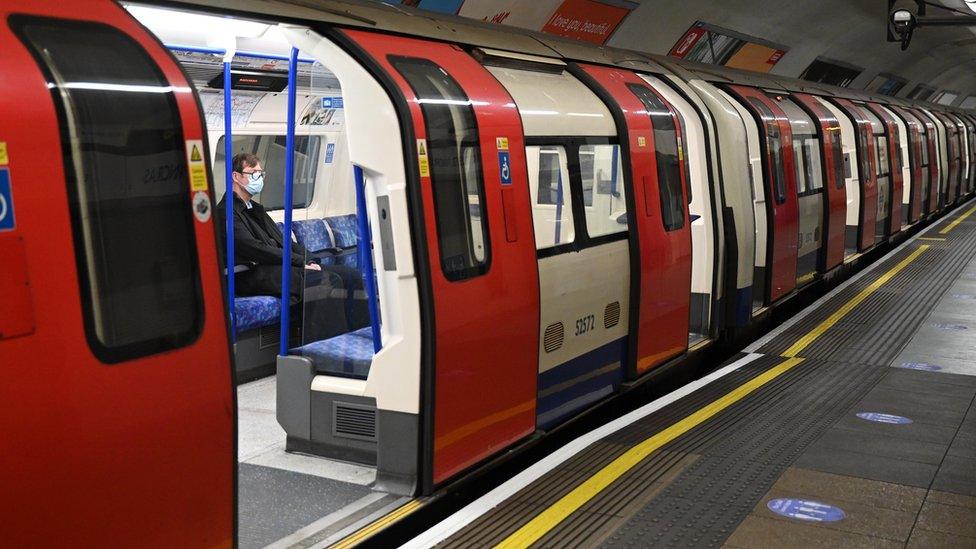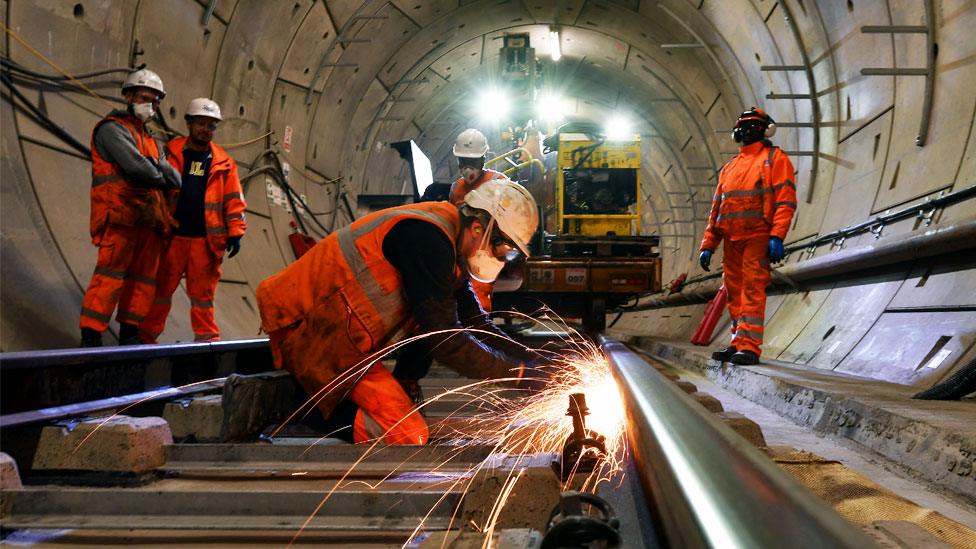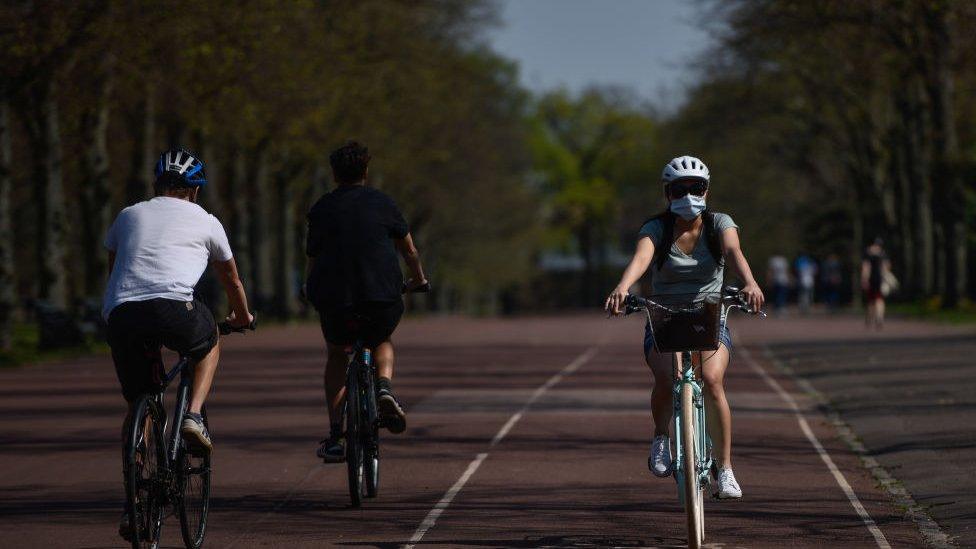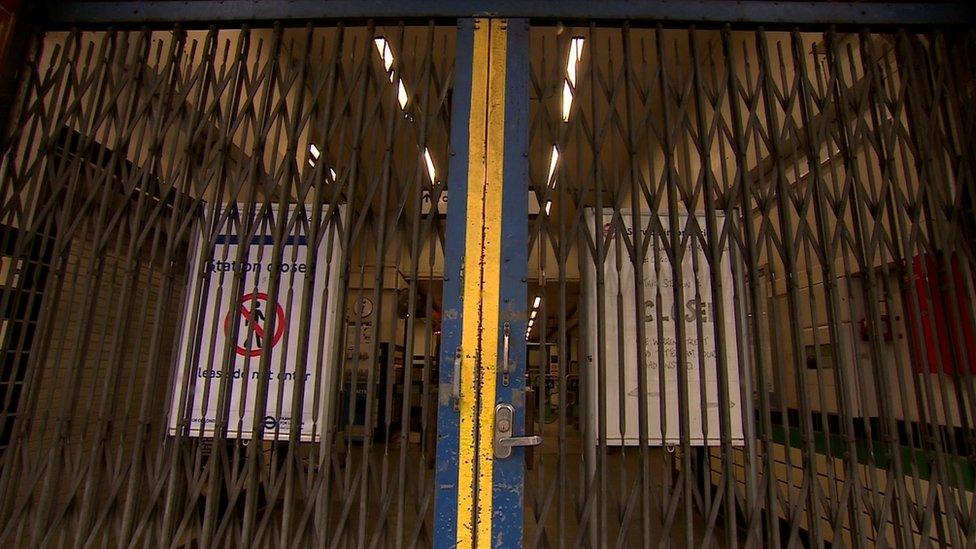Coronavirus: Perfect storm brewing at Transport for London
- Published
- comments

Income from fares has "reduced to a trickle" for Transport for London
London transport faces a massive challenge unlike anything it has encountered before.
Transport for London (TfL) as an organisation was already making cuts to balance its books but it is now wrestling with the evaporation of its biggest revenue generator - fares.
In 2019/20 fares made up 47% of its income at £4.9bn. Now it has been reduced to a mere trickle.
Not only is it grappling with reduced income but it still has to run services.
The nightmare scenario for TfL, as well as other transport operators, is that passengers do not return to mass transit after the lockdown is over.
Cities could face huge upheavals in travel.

Commuters on the Central line pack into a rush hour Tube carriage

Transport use fell by 60% between early February and the beginning of April, according to the Department for Transport
The latest figures given to me show that it is costing £600m a month to run the entire London transport network.
It obviously cannot do that indefinitely with a very low fares income and so it is in discussion with central government about more funding.
But that may mean strings are attached.
'Nothing off the table'
Now TfL is looking to furlough non-front line non-operational staff through the Job Retention Scheme.
Insiders have told me that could mean thousands of TfL staff. They will get 80% of their salary paid for by government and TfL will pay the rest.
Also in the mix is that all future capital projects are now being reviewed which could mean delays and cancellations to projects like the Piccadilly line upgrade, the Barking Riverside Extension, Crossrail 2.
Insiders were very clear: nothing is off the table.
To be frank, if people are no longer travelling to offices and perhaps working from home more regularly, then a reassessment of capital projects is probably prudent.
Will London continue to grow?

Central sections were expected to open three years late in summer 2021, but that was before the lockdown
Crossrail could also be delayed and not open by summer 2021.
In response to a question, external from Caroline Pidgeon, the Liberal Democrat on the London Assembly, the Mayor of London revealed "upwards of 2,000 people from across Crossrail Ltd and their supply chain are now working from home"
The response added: "It is too early to tell exactly how the impact of coronavirus will be felt on the project.
"Crossrail Ltd is developing a detailed remobilisation plan with its contractors to enable physical works at stations to get back up and running as soon as the current rules start to be eased."
I am told there could also be contractual claims from construction companies being told to stop work by London mayor Sadiq Khan.
Changing habits
Another concern is how people have changed their behaviour.
In Wuhan, where the coronavirus pandemic began, bus and metro use before the lockdown was 56% of journeys and that has now fallen to 24% after the city's lockdown was lifted, according to an Ipsos report., external
That was matched by an increase in car use from 34% to 66%.
Travel habits will clearly take some time to recover.

Transport habits in London are changing under the coronavirus lockdown
A car increase like that would have a significant impact on congestion and gridlock, as well as pollution levels, in London.
What organisations like the London Cycling Campaign and Living Streets want is for the capital to follow the examples set elsewhere and close streets to motor vehicles.
Milan wants to repurpose 22 miles (35km) of road over to walking and cycling.
Colombia has turned over roads to bike lanes, Berlin has expanded its bike lanes and Brussels is reducing speed to 12.5 mph (20kmph) in the central area.
Sadiq Khan always had ambitions to make London easier to walk and cycle in but as yet there's no indication if he will follow other cities and move more roads away from vehicles.

Mayor of London, Sadiq Khan, has campaigned to make it easier to walk and cycle in the capital
A TfL spokesperson said: "The success of the vital advice for people to stay at home and to only make essential journeys has seen a huge reduction in passenger numbers.
"We have minimised our operational costs significantly over recent years, meaning it costs around £600m a month to run our entire transport network.
"We are having constructive discussions with the Government about the support we need so that we can continue to serve the city effectively and carry on with the vital work that needs to be done during the pandemic and support the national effort to beat it."

What do I need to know about the coronavirus?
A SIMPLE GUIDE: How do I protect myself?
AVOIDING CONTACT: The rules on self-isolation and exercise
HOPE AND LOSS: Your coronavirus stories
LOOK-UP TOOL: Check cases in your area
VIDEO: The 20-second hand wash


- Published19 March 2020

- Published24 March 2020

